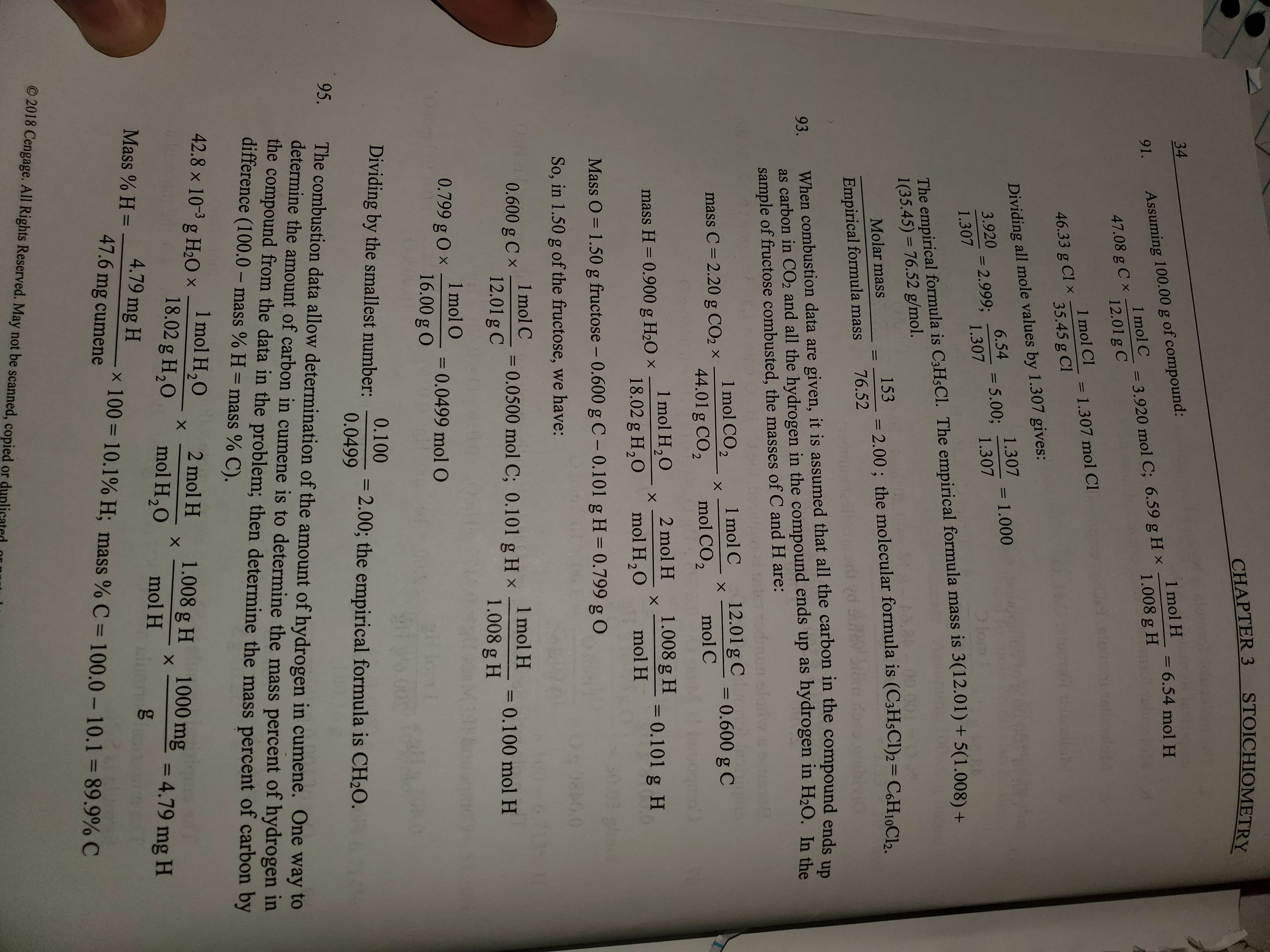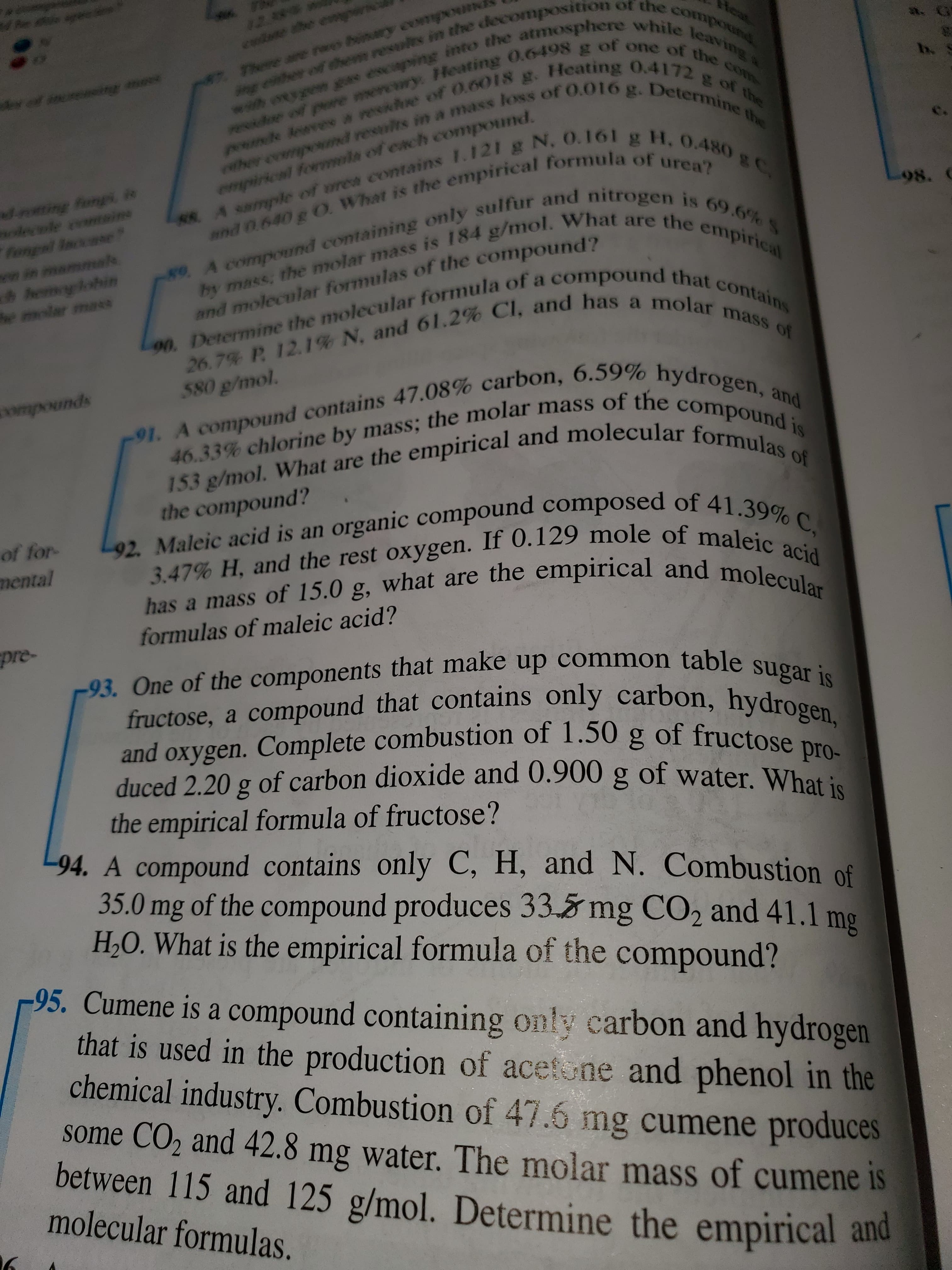STOICHIOMETRY CHAPTER 3 34 Assuming 100.00 g of compound: 1 mol C 1 mol H = 6.54 mol H 91. 1.008 g H 3.920 mol C; 6.59 g H x 47.08 g 12.01 g C 1 mol Cl = 1.307 mol CI l1 46.33 g Cl35.45 g CI Dividing all mole values by 1.307 gives: 6.54 3.920 2.999, 1.307 = 5.00. 1.301 1.000 1 lom 1.307 The empirical formula is C3H5CI. The empirical formula mass is 3(12.01) + 5(1.008) + 1(35.45) 76.52 g/mol. 2.00; the molecular formula is (C3H5CI)2= C6H10C 2 76.52 M.800.091 Molar mass 1 Empirical formula mass When combustion data are given, it is assumed that all the carbon in the compound ends up as carbon in CO2 and all the hydrogen in the compound ends up as hydrogen in H20. In the sample of fructose combusted, the masses of C and H are: 93. 1 mol CO2 C = 2.20 g CO2 44.01 g CO2 1 mol C 12.01 g C0.600 g C X X X mol CO2 mol C 1.008 g H 0.101 g H 1 mol H2O 18.02 g H20 2 mol H mass H 0.900 g H2O x X mol H2O mol H Mass O 1.50 g fructose - 0.600 gC- 0.101 g H = 0.799 g O 0.0 So, in 1.50 g of the fructose, we have: 1 mol C 0.600 g 12.01 g C =0.0500 mol C; 0.101 g Hx molH 1.008 g H = 0.100 mol H 0.799 g Ox 1mol O 0.0499 mol O Dividing by the smallest number 0.1002.00; the empirical formula is CH2O. 0.0499 95. The combustion data allow determination of the amount of hydrogen in cumene. One way to determine the amount of carbon in cumene is to determine the mass percent of hydrogen in the compound from the data in the problem; then determine the mass percent of carbon by difference (100.0- mass % H mass % C). 1 mol H2O 18.02 g H20 42.8 x 10-3 g H20 2 mol H 1.008 g H X 1000 mg mol H20 4.79 mg H mol H Mass % H= 4.79 mg H x100 47.6 mg cumene 10.1 % H; mass % C 100.0-10.1 = 89.9% C 2018 Cengage. All Rights Reserved. May not be scanned, copied or du Rhe r eiher of then resuls in the decomosition of the compound wh wyyonga esciaping into the atmosphere while leaving & xixdoe of pore mercwry: eating 0.6498 g of one of the com peouihde Reavew a resikdue of O.6018 g. HHeating 0.4172 g of the her comnpend results in a mass loss of O.O16 g. Determine the 28 9 tear ay: a 4 2. Fhne ancrao binary eowmpoun b 4af u n 88A sample of urea contains 1.121 g N, O.161 g H. 0.480 gC. fongi i dele omeins fangal se in mammale hemlohin e molar mass empirical formla of each compound. and 0.640g O What is the empirical formula of urea? 98. 8e A compoInd containing only sulfur and nitrogen is 69.6% S hy mass, the molar mass is 184 g/mol. What are the empirical 90. Determine the molecular formula of a compound that contains and molecular formulas of the compound? 26.7% P. 12.1% N. and 61.2% Cl, and has a molar mass of 580 g/mol. 91. A compound contains 47.08% carbon, 6.59% hydrogen, and 46.33% chlorine by mass; the molar mass of the compound i 153 g/mol. What are the empirical and molecular formulas of **wmpounds the compound? L92. Maleic acid is an organic compound composed of 41.39% C, 3.47% H, and the rest oxygen. If 0.129 mole of maleic acid has a mass of 15.0 g, what are the empirical and molecular of for- mental formulas of maleic acid? pre- -93. One of the components that make up common table sugar is fructose, a compound that contains only carbon, hydrogen, and oxygen. Complete combustion of 1.50 g of fructose pro- duced 2.20 g of carbon dioxide and 0.900 g of water. What is the empirical formula of fructose? 94. A compound contains only C, H, and N. Combustion of 35.0 mg of the compound produces 33.5 mg CO2 and 41.1 mg H20. What is the empirical formula of the compound? 95. Cumene is a compound containing only carbon and hydrogen that is used in the production of acetone and phenol in the chemical industry. Combustion of 47.6 mg cumene produces some CO2 and 42.8 mg water. The molar mass of cumene is between 115 and 125 g/mol. Determine the empirical and molecular formulas. 20 00
Ideal and Real Gases
Ideal gases obey conditions of the general gas laws under all states of pressure and temperature. Ideal gases are also named perfect gases. The attributes of ideal gases are as follows,
Gas Laws
Gas laws describe the ways in which volume, temperature, pressure, and other conditions correlate when matter is in a gaseous state. The very first observations about the physical properties of gases was made by Robert Boyle in 1662. Later discoveries were made by Charles, Gay-Lussac, Avogadro, and others. Eventually, these observations were combined to produce the ideal gas law.
Gaseous State
It is well known that matter exists in different forms in our surroundings. There are five known states of matter, such as solids, gases, liquids, plasma and Bose-Einstein condensate. The last two are known newly in the recent days. Thus, the detailed forms of matter studied are solids, gases and liquids. The best example of a substance that is present in different states is water. It is solid ice, gaseous vapor or steam and liquid water depending on the temperature and pressure conditions. This is due to the difference in the intermolecular forces and distances. The occurrence of three different phases is due to the difference in the two major forces, the force which tends to tightly hold molecules i.e., forces of attraction and the disruptive forces obtained from the thermal energy of molecules.
Please explain to me, 1 step at a time, how to solve #93. I am not sure what they are doing on each step of the solution, they are just combining it into one long math problem, and I dont understand what each step is doing


Trending now
This is a popular solution!
Step by step
Solved in 3 steps with 3 images









